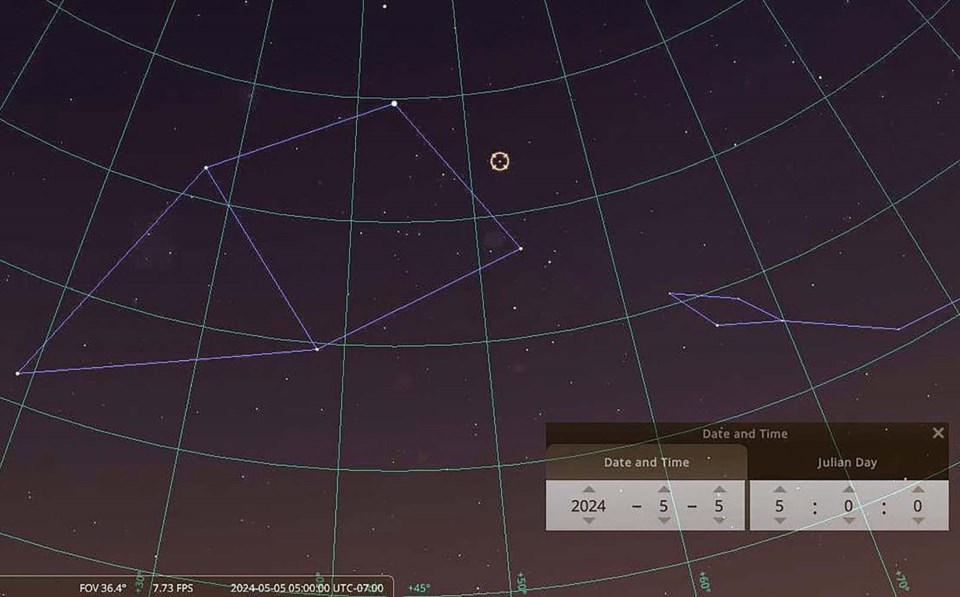The Eta Aquariids meteor shower peaks about local noon on May 5 but has a peak spread over about five days so early mornings for a few days before and after should be productive. The radiant rises above the eastern horizon by about 03:00 each morning and while the meteors will appear to radiate outwards from that point they can actually appear anywhere in the sky, even in the west. As usual, no viewing aids are necessary or desired, just find a good spot, lie back and look up. The ZHR (Zenithal Hourly Rate) is about 60 which is very decent and the waning moon disappears by May 6. One very interesting possibility for the morning of May 5 is the chance to see a thin crescent moon, Mars and Saturn low in the ESE around 04:50 when they will be joined by a setting International Space Station (ISS). The radiant for the meteors of the Aquariid shower is just above and right of the moon and planets.
Today I learned that the source of the Eta Aquariids is good old Halley’s Comet! What I also didn’t know is that the same comet is also the source for the Orionids shower in October. I’m still trying to figure out how the comet’s orbit can intersect our own twice unless it orbits in the same plane. Apparently, Halley’s has a retrograde orbit (goes in the opposite to the planets) with an inclination of about 18 degrees to the ecliptic. Maybe that’s close enough? Anyway, it just passed aphelion (farthest point from the sun) in December 2023 and will return for our younger readers in 2061. I’ll probably have lost interest by then, if you know what I mean. I did see it in 1985, though, during a trip to New Zealand; neat, but not as cool as the Magellanic clouds.
April’s morning series of ISS passes continues into May, as mentioned above. However, as we move towards summer, the nights get shorter and we become able to see both morning and evening passes starting by May 9. This will continue until the morning passes quit by May 22 and we’re stuck watching the ISS at civilized evening times. Interestingly, most of the evening pass predictions seem to show the ISS rising fully lit in the west and proceeding all the way to the eastern horizon, instead of rising in the dark and hitting sunlight halfway across the sky. Check the Heavens-Above website for this info.
Comet 12P Pons-Brooks and Jupiter are vanishing in the western glare of sunset by late April. The comet will continue into the southern sky and Jupiter will be behind the sun (superior conjunction) on May 18. It will reappear before sunrise beginning in June.
One interesting bit of stellar trivia caught my eye recently: the Garnet Star a.k.a. Mu Cephei. It was noted by William Herschel, who described it as “a very fine deep garnet colour, such as the periodical star Omega Ceti,” according to Wikipedia. It’s a reddish star just below the “base” line of Cepheus and is of variable magnitude about 4.2. Once you find Cepheus, it’s an easy catch with binoculars and the colour is more noticeable. The accompanying screen shot shows Cepheus and the star location (highlighted).
This one gets more interesting: it has an estimated mass of about 20 times that of our sun, an age of about 10 million years (cf. 4,500 million for our sun) and a radius about 1,000 times that of our sun. To picture that, replace our sun with this monster and it would occupy the space out to Jupiter! The reason for all this weirdness is because massive stars age so much faster than ones the size of our own. Once the helium from hydrogen fusion builds up in the core, gravitational pressure compresses and heats it and it begins to fuse into carbon, releasing more energy. Rinse and repeat for each fusion product. The short version is that the star expands to a red giant, the surface temperature drops and it winds up with multiple layers of fusion reactions, all making heavier elements culminating in iron. Once that forms, the end comes in days; the iron core won’t fuse and gets crushed into neutrons and collapses. The outer layers collapse, then rebound in a colossal explosion. If the result of that supernova core is a neutron star, it’d be about the size of the city of Vancouver; if a black hole, smaller. Most of the rest is blown off into interstellar space.
Continuing repairs to the Sechelt Library mean the SCAC monthly meeting will be held at the Sechelt Seniors Activity Center from 7 to 9 p.m., Friday, May 10. The speaker details will be available on the club website at: sunshinecoastastronomy.wordpress.com/






